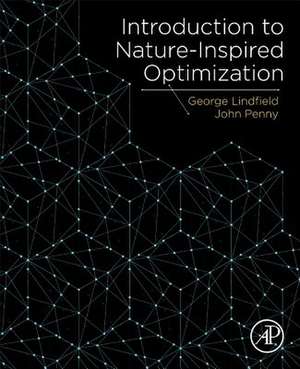Introduction to Nature-Inspired Optimization
Autor George Lindfield, John Pennyen Limba Engleză Paperback – 11 aug 2017
Nature-inspired algorithms emulate processes that are found in the natural world, spurring interest for optimization. Lindfield/Penny provide concise coverage to all the major algorithms, including genetic algorithms, artificial bee colony algorithms, ant colony optimization and the cuckoo search algorithm, among others. This book provides a quick reference to practicing engineers, researchers and graduate students who work in the field of optimization.
- Applies concepts in nature and biology to develop new algorithms for nonlinear optimization
- Offers working MATLAB® programs for the major algorithms described, applying them to a range of problems
- Provides useful comparative studies of the algorithms, highlighting their strengths and weaknesses
- Discusses the current state-of-the-field and indicates possible areas of future development
Preț: 556.83 lei
Preț vechi: 727.14 lei
-23% Nou
Puncte Express: 835
Preț estimativ în valută:
106.56€ • 115.71$ • 89.51£
106.56€ • 115.71$ • 89.51£
Carte tipărită la comandă
Livrare economică 15-29 aprilie
Preluare comenzi: 021 569.72.76
Specificații
ISBN-13: 9780128036365
ISBN-10: 0128036362
Pagini: 256
Ilustrații: 75 illustrations
Dimensiuni: 191 x 235 x 20 mm
Greutate: 0.52 kg
Editura: ELSEVIER SCIENCE
ISBN-10: 0128036362
Pagini: 256
Ilustrații: 75 illustrations
Dimensiuni: 191 x 235 x 20 mm
Greutate: 0.52 kg
Editura: ELSEVIER SCIENCE
Cuprins
1. Introduction2. Genetic algorithms (GAs).3. Artificial bee colony (ABC) algorithm 4. The bat algorithm.5. Strawberry optimization algorithm6. Ant colony optimization (ACO)7. Cuckoo search algorithm8. Other algorithms and hybrid algorithms9. General comparison of the nature of the methods
Recenzii
"Besides being very useful to those who are interested in discrete optimizations problems and applying various nature-inspired metaheuristics to them, the involved reader can also benefit from comparative studies of algorithms highlighting their strengths and weaknesses.
The book is written in a clean and easily uderstandable, but still highly scientific language and it is beneficial reading for post-docs and researchers working with MATLAB and interested in metaheuristic approaches to optimization problems." --Zentralblatt MATH
The book is written in a clean and easily uderstandable, but still highly scientific language and it is beneficial reading for post-docs and researchers working with MATLAB and interested in metaheuristic approaches to optimization problems." --Zentralblatt MATH
